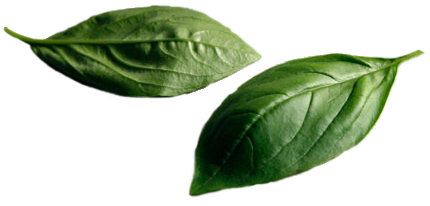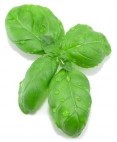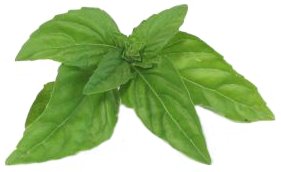

Basil

Ocimum. (Plant name used by Theophrastus.) Labiatae. Some thirty-five species of aromatic annuals, perennials and shrubs. Stems erect, usually branching. Leaves opposite, petiolate or rarely sessile. Inflorescences of 6-flowered verticillasters arranged in a lax or dense spike; bracts small or large, occasionally brightly coloured, sometimes forming a terminal coma; calyx peristent, bilabiate, tubular, upper lip large, entire, accrescent, lower lip subequally 4-lobed, teeth of lateral lobes lanceolate or deltoid; corolla bilabiate, white, green or pink, tube straight or funnelform, subequal to calyx or exserted, upper lip subequally 4-lobed, lower lip entire; stamens 4 declinate, exserted from corolla tube. Nutlets brown or black, ovoid or round. Old World Tropics. Z10. CultivationOcimum basilicum is one of the most important culinary herbs; the leaves are used in salads, casseroles, sauces and certain liquers. Ocimum tenuiflorum is a Hindu sacred herb, used in funeral rites as an emblem of good luck, and widely cultivated for anti-malarial fumigation. Other species are useful in cooking but are also medicinal having antiseptic and febrifugal properties. Although most species are more or less perennial, in cool temperate climates the basils are best treated as tender annuals sown under glass in spring, potted on under glass and planted out once summer is well under way. Ocimum basilicum and its cultivars may be sown into a soilless compost and grown on in a similiar medium benefiting from the water-retentive properties of such a compost in its formative months. In hotter climates two or more crops per year are possible. Mildew can be a problem in hot dry summers, for which a suitable specific fungicide may be applied. Aphids are attracted by the succulent new growth and can cause unsightly distortion of the plants by damaging the growing points. Care should be given when spraying insecticides as Ocimum basilicum is susceptible to phytotoxicity; pyrethrum-based insecticides are fairly safe as are fully organic methods which avoid the use of chemicals of any kind in their entirety. Other methods of control may require the use of a controlled environment such as that found in a glasshouse where temperature, moisture and humidity can be managed as required. The cultivation of plants in individual pots in the glasshouse may also aid in the control of mildew, insects and other problems as well. Ocimum basilicumCOMMON BASIL; SWEET BASIL. Aromatic annual or short-lived perennial, 20-60cm. Stems erect or ascending, woody at base, branching, glabrous, minutely pubescent on inflorescence axis. Leaves 1.5-5 x 0.5-2cm, narrowly ovate to elliptic, margins entire to serrate, apex acute to acuminate, surfaces glandular punctate; petiole to 4cm. Inflorescence lax, verticillasters 8-20mm apart; bracts 3-8mm, deciduous or peristent, narrowly ovate to elliptical; calyx 2-3mm, enlarging in fruit to 6mm, more or less downward-pointing, upper lip glabrous, lower lip pubescent, gland dotted, tube pilose with a ring of hairs in the throat; corolla 5-8mm, pink, white or creamy yellow, tube straight, scarcely exserted from calyx. Nutlets black, mucilaginous when wet. Tropical Asia. ‘Citriodorum’: leaves lemon-scented. ‘Crispum’: leaves curled around the edges. ‘Minimum’ BUSH BASIL; GREEK BASIL: 15-30cm; leaves very small, less than 1cm long, ovate. ‘Purple Ruffles’: leaves purple, curled around the edges. ‘Purpureum’ (‘Dark Opal’): leaves red-purple, clove-scented. ‘Spicy Globe’: compact and globose; leaves small; flowers white. Ocimum tenuiflorum
HOLY BASIL. Aromatic woody or suffrutescent herb to 1m. Stems erect, branched, woody at base, covered in spreading hairs. Leaves 1.5-3 x 1.1-2cm, broadly elliptical, petiolate, margin serrate, both surfaces covered in short hairs, petiole 7-15mm. Inflorescence lax; calyx 1mm enlarging in fruit to 3mm, throat open and glabrous; corolla to 3mm, pink or white, tube parallel-sided, lower pair of stamens ciliate near bases. Nutlets brown, mucilaginous when wet. India and Malaysia. There are a number of synonyms for the species featured here. Other Ocimum species are not included for reasons of culinary and/or cultural relevance.
|
Home
Grow Nuts
Grow Fruit
Grow Vegetables
Cyberian Index
If you like this website and want one of your own contact
Cyberian All information correct at
time of publication and open to updates as necessary. No part of this website,
or its vectors, may be produced in any shape or form, using any type or design
of medium, system, equipment or otherwise without the prior written consensual
notice of the Cyberian. Any breach of these requirements will result in the
appropriate action. If in doubt, e-mail contact is recommended.
Some components of this website were obtained as open-source software and are
used in the same non-profit manner on this website.